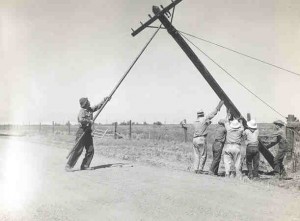The Civilian Conservation Corps was envisioned as a peacetime army to put young men to work preserving the nation’s forests and wildlife. When Congress approved funding in 1934 to add eight million acres to the National Wildlife Refuge System, the CCC spread out across the country to build it. In May 1937, two hundred CCC enrollees arrived in California to start construction of the Sacramento Migratory Waterfowl Refuge.
The goal was to provide habitat for migratory birds and wildlife on 10,700 acres of failed farmland in the Central Valley. The Bureau of Biological Survey—later renamed the U.S. Fish and Wildlife Service—oversaw the work. As it was the Biological Survey’s second wildlife refuge, the CCC camp was named BS-2.
Heavy equipment was in short supply that first summer and much of the work was done by pick and shovel. The men restored some ranch buildings for offices, and demolished others using the salvaged materials for camp repairs and project work. Mosquito bitten, sunburned, and dust-choked, the men worked year round constructing levees, dikes, and jetties; laying pipe; and clearing creeks, channels, and drains to create wetlands for the refuge. They planted rice and millet within the refuge in order to keep the waterfowl from feeding on nearby farmland.
In summer, CCC crews fought wildfires in the surrounding foothills and mountains. In bad winters, they helped sandbag against flooding in the small towns along the Sacramento River some ten miles east.
While few camp buildings survive, a 100-foot tower built as a fire lookout still stands today. Biologists likely used the tower when they tallied 36,000 ducks and 72,000 geese on the refuge in December 1937. In December 1938 more than a million birds were counted.
Today, the site of CCC camp BS-2 serves as the headquarters of the Sacramento National Wildlife Refuge Complex. The present pond system and many dikes and roadways are products of the summer of 1937. The refuge welcomes some 250 species of birds, hundreds of thousands of wintering waterfowl, and 75,000 visitors annually.
The headquarters area is eligible for designation as a National Historic District, but there’s currently no funding to preserve the structures to Historic District guidelines.
What the CCC Build at the Sacramento National Wildlife Refuge:
– 52 water control and road structures
– 1 diversion dam
– 1 combined bridge and dam
– 16 miles of refuge roads
– 10 miles of fence
– Manager’s residence and garage
– Labor patrolman’s cabin
– Equipment storage shed
– Service Building
– Water tank
– Lookout tower
– Refuge office
– Barn
– Duck hospital
– Grain bins
– Flag pole
– Miles of dikes
– Numerous nesting and resting islands
– Farmland producing feed for wildlife
– Entrance and location signs
- Blue Goose Work at Sacramento Refuge
- 1937 Canal Cleaning
- Survey work at Sacramento Refuge
With thanks to Lora Haller, Visitor Services Manager at the Sacramento National Wildlife Refuge.






Thanks for highlighting this important CCC contribution. I recommend your article indicate this area is near Willows, CA.
The CCC Legacy camp list for California (https://www.ccclegacy.org/CCC_Camps_California.html) shows this project being BR-2 (R indicates a reclamation project which makes more sense than it being a survey project given all the improvements that were made). The work was done by Company 1920-V (V indicates a veteran’s company)
Tim Montgomery
Secretary
CCC Legacy
I can see in the blow-up of the entrance sign picture that biological survey may be the accurate description of this work. Perhaps the compilers of the CCC Legacy camp lists were mistaken.
Surprised the article did not include gps coordinates from the Living New Deal map.
Thank you, Lora, for the great article – well written and easy to read the highlighted accomplishments of the CCC – wonderful and grateful.
This location is not indicated on the Living New Deal under CCC projects. Please add it.
I agree that the CCC Legacy camp list listing mentioned above needs to be corrected to BS-2.
We have tagged it under “CCC” projects. Please let us know if you’re having trouble with it.